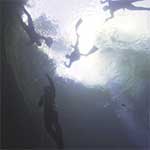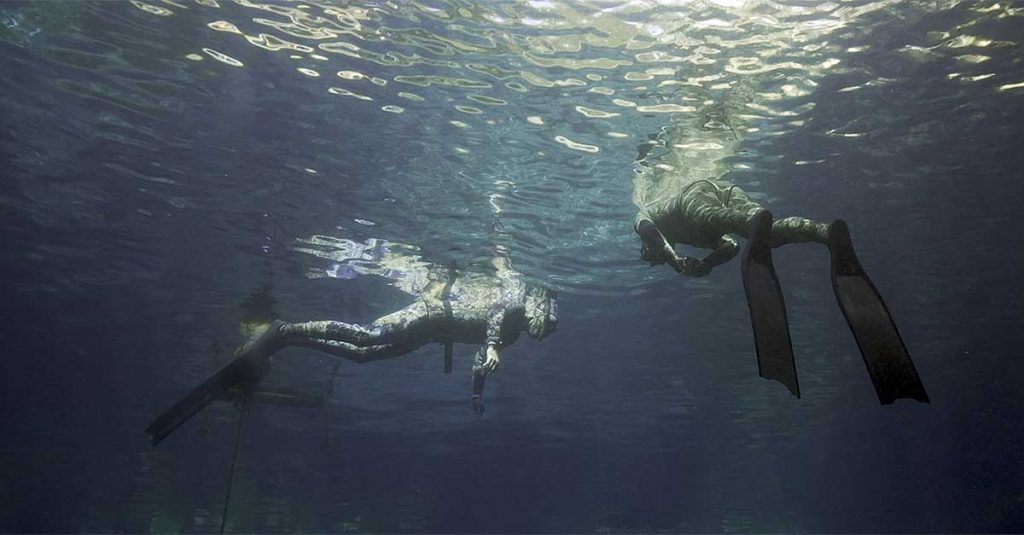 It’s no secret freediving has enjoyed a tremendous surge in popularity in just the past few years. Long fins, camouflaged wetsuits and all the other trappings of freediving are showing up everywhere. Unfortunately, most of the people we see using it have no idea what they are doing and, as a consequence, die all too frequently.
It’s no secret freediving has enjoyed a tremendous surge in popularity in just the past few years. Long fins, camouflaged wetsuits and all the other trappings of freediving are showing up everywhere. Unfortunately, most of the people we see using it have no idea what they are doing and, as a consequence, die all too frequently.
If you are considering getting into freediving, or you have friends or family members who are, here are nine things both you and they need to keep in mind…before yet another wannabe freediver wakes up dead.
1 It’s not the same as “snorkeling”
It’s important to understand the difference between freediving and snorkeling.
- Snorkeling is what your aunt and uncle were doing when they went on that cruise last year. It generally involves simple masks and snorkels, and relatively small fins. Snorkelers may never leave the surface or, if they do, seldom go deeper than the deep end of a swimming pool. They may even wear inflatable vests “just in case.”

- Freediving involves the use of highly specialized equipment, including long-bladed fins. Freedivers employ a number of highly specialized techniques designed to maximize depth and bottom time while subjecting themselves to minimal risk.
In fact, about the only significant thing freediving and snorkeling have in common is that their participants don’t use tanks.
2 What you learned in scuba class isn’t freediving
Fifty years ago, the assumption was that you couldn’t learn to scuba dive unless you were first an accomplished “skin diver.” The first three sessions of my ten-lesson scuba course in the early 1970s were devoted entirely to diving without tanks. The irony was, the equipment we were using (Rocket Fins and high-volume, wraparound masks) was very poorly suited for freediving. In fact, it’s hard to imagine worse.
Today, scuba classes are considerably shorter and devote little, if any, time to diving without tanks. When they do. instruction is generally limited to:
- Depths no deeper than those of a swimming pool.
- Surfacing immediately upon feeling the first urge to breathe.
Within those limitations, what students learn is not especially dangerous. But it’s not freediving.
3 The risks are substantial
Any time you are in or around water, there is a risk of drowning. The water doesn’t even have to be over your head. People have drowned in puddles.
Because freediving takes place in water, the risk of drowning is always present. There are risks inherent in freediving, however, that make the risk of drowning even greater when freediving than it may be while swimming or scuba diving.
Chief among these risks is blackout. Blackout can occur when the partial pressure of oxygen (PO2) in blood and tissues is too low to sustain consciousness.
- To maintain consciousness, the partial pressure of oxygen in your blood and tissues must be at least 0.1 ATA. That’s the equivalent of breathing a gas mixture containing just 10 percent oxygen at the surface. (Atmospheric air has an oxygen concentration of 21 percent.)
- Bear in mind, however, that the risk of blackout increases any time PO2 levels drop below 0.16 ATA. That’s the equivalent of breathing a gas mixture containing 16 percent oxygen at the surface — the concentration of of oxygen typically found in exhaled air.
Things become more complicated at depth, however. That’s because ambient pressure has a direct impact on the partial pressure of oxygen in blood and tissues.
- Let’s say you are at a depth of 10 m/33 ft, where the ambient pressure is twice what it would be at sea level. Let’s also assume that the concentration of oxygen in your blood and tissues is the equivalent of what would be a PO2 of 0.09 ATA at the surface. Therefore, at a depth of two atmospheres, the effective PO2 is twice this, or 0.18 ATA. That’s enough to sustain consciousness.
- As you ascend, however, ambient pressure drops and with it the effective partial pressure of oxygen. Before you even reach the surface, PO2 levels drop below 0.1 ATA and you black out.
Lets face it: If you lose consciousness under water while freediving, you will most likely drown — unless you have a qualified freediving buddy standing by who can rescue you.
However, if you make it back to the surface without passing out, you’re home free…right? Well, not exactly.
4 Blackout: It’s not just for shallow water
Odds are, you’ve already heard the term shallow water blackout. It refers to the situation just described, in which a freediver passes out while ascending, due to a rapid drop in the partial pressure of oxygen in blood and tissues.
So, you may be thinking, “As long as I can make it back to the surface and resume breathing, there will be no more risk of blacking out.” Guess again.
According to Performance Freediving International (PFI), the risk of blacking out during the first minute after surfacing is actually greater than the risk of blacking out during ascent. This is because recovery from a rapid drop in PO2 is not instantaneous. It takes up to a minute of recovery breathing after surfacing to return PO2 to safe levels.
Blacking out while unattended at the surface can be every bit as dangerous as blacking out during ascent. If you can’t maintain an open airway and keep your face out of the water, you will most likely drown.
5 A trained buddy is essential
At this point, one thing should be abundantly clear: The presence and full attention of a qualified buddy is absolutely essential for safer freediving. This is the person you must be able to depend on to bring you to the surface if you pass out under water. And, should you pass out at the surface, you need to be able to rely on your buddy to keep your airway open and your face out of the water.
It isn’t enough that your buddy is simply present. He or she must:
- Be totally focused on where you are and what you are doing whenever you are under water.
- Be capable of reaching you and bringing you to the surface should you pass out under water.
- Know how recognize and respond to the signs of blackout, both at the surface and under water.
Unfortunately, we see all too many wannabe freedivers who think that solo freediving is no big deal. These are the ones who die.
6 Overhead environments are never okay for freediving
As you read earlier, the only way a buddy can maintain eyes-on contact with you during a freedive — and respond quickly enough should something happen — is if he or she can see you at all times. That can’t happen if you disappear into a hole in the ground, or inside a wreck.
Here in cave country, we frequently see solo freedivers enter the caverns at Ginnie Spring, Devil’s Eye and elsewhere. It’s not a matter of if they will perish; several already have.
Sadly, people are not getting the message. Go to You Tube and search for Freediving Devil’s Eye. You’ll see numerous videos posted by idiots trying hard to be the next statistic.
7 You Tube can get you killed
Speaking of You Tube, you’ll discover it’s full of videos devoted to freediving. Unfortunately, even the ones that provide otherwise helpful and accurate information can be problematic. Why? Because they only provide part of the story. For the uninformed, these videos too often suggest that freediving is a discipline you can teach yourself. That’s a good way to get killed.
Of even greater concern are the videos showing dangerous behavior, such as the ones depicting freedives into overhead environments. Unfortunately, these videos do not come with warning labels. There is nothing to inform the uninitiated that what they are seeing is a good way to die.
8 A garden of misinformation
Misinformation about freediving isn’t limited solely to You Tube. Sometimes you need to look no further than entry-level scuba training materials.
For years, at least two popular beginning scuba texts showed people “skin diving” in horse-collar BCs or similar devices. The implication was that this was how you established and maintained positive buoyancy on the surface after a freedive.
More recently, we saw an Open Water Diver class doing a “skin dive” while wearing bulky, jacket-style BCs without tanks. Students were being taught to orally inflate these BCs every time they surfaced from a breath-hold dive, lest they sink.
Let’s think about this. By definition, you surface from a breath-hold dive with a diminished oxygen level and elevated CO2 level. The last thing you need to be doing at this point is hyperventilating into a bag.
Real freedivers would never dream of wearing any sort of inflatable device. What they do instead is wear full-length exposure protection in the form of a wetsuit that guarantees they can float at the surface without effort.
They then weight themselves for neutral buoyancy at a depth of no shallower than 5 m/16 ft. Many freedivers shoot for being neutrally buoyant at a depth of 10 m/33 ft. This helps ensure several things:
- Should freedivers suffer a shallow-water blackout during the final portion of their ascent, they will continue to float to the surface automatically.
- Should their buddies come to their aid at this point, it will be easier to get the blacked-out diver to the surface and keep him or her there.
- Once a properly weighted freediver surfaces, there will be no need to struggle to stay there. The freediver can relax and perform the necessary recovery breaths without further elevating CO2 levels or unnecessarily consuming oxygen.
Freedivers who need additional support will generally use a surface float. This can provide a mounting point for dive flags and an attachment point for descent/ascent lines. More importantly, it’s always inflated. To gain additional support, you simply need to reach out and grab the float.
9 Get trained or get dead
By now it should be apparent that freediving is not something you can teach yourself — any more than you can teach yourself to scuba dive or fly an airplane. Fortunately, comprehensive freediver training is available from qualified instructors. And, with the support of major diver training organizations, it’s more readily available than ever.
You will be amazed at the depth of knowledge and skills covered in the typical entry-level freediving class. It’s much more than just how to maximize depth and bottom time. Freediving students also learn about:
- Specialized equipment for freediving
- Specialized breathing techniques for before and after freedives
- Preventing blackout
- Responding to blackout
- How not to end up a statistic
If you would like to learn more about freediver training and courses available in your area, visit the Performance Freediving International website.
